Entomology’s 2019 Insect Fear Film Festival Touts the Terrific Termite
March 18, 2019
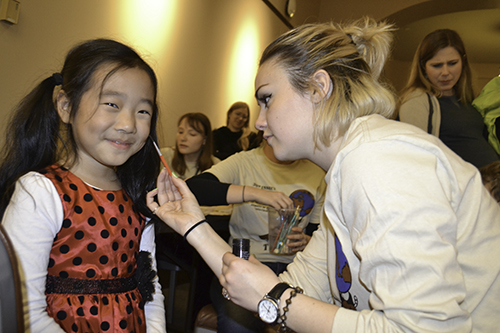
An Illinois Entomology student (right) paints an insect on the face of a young visitor.
Lest anyone get the wrong idea about the 36th annual Insect Fear Film Festival (IFFF), the event wasn’t just to celebrate scary (or cheesy, perhaps?) movies about an insect. The February 23rd event was actually a love-fest celebrating insects, particularly the star of the evening, the termite. Sponsored by Entomology and the EGSA (Entomology Graduate Student Association), the goal of the evening was to help folks overcome their fear of insects, plus to educate them that not all insects are pests, but that many are actually useful. And of course, the overarching goal for the evening was for everyone to have fun.
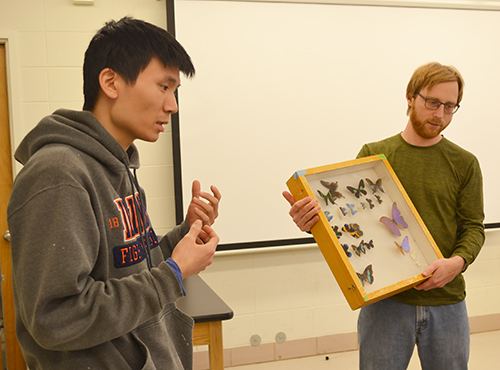
EGSA Outreach Coordinators, Ed Hsieh and Scott Clem, discuss insects during a recent outreach.
Coordinating the 2019 IFFF were members of the EGSA, including its two Outreach Coordinators, Scott Clem and Ed Hsieh. Clem explains why he got involved with EGSA outreach. “So I just decided I really like doing outreach. I really like bringing bugs to people and kinda reducing that fear barrier between people and insects.” He also seeks to show people that while many insects can be “pesky, the majority of them are useful for a variety of reasons,” he says. “We need to appreciate them is what I'm trying to advocate, I guess."
Clem says the IFFF was a collaborative effort between the EGSA and the Entomology Department Head, May Berenbaum, who began it and has been heading it up for years. Berenbaum usually develops the theme and comes up with the movies, while Entomology’s grad students do the rest. “It's part of our department's way of reaching out to the public,” Clem asserts.
Every year the IFFF has a different theme; this year the star of the show was…termites!
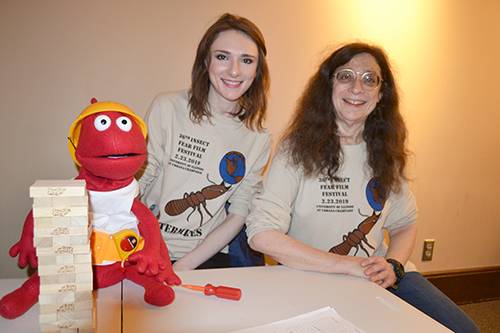
Creater of the Insect Fear Film Festival, Entomology Professor and Department Head May Barenbaum (right), and her daughter, Hannah Laskowski, a regular at the Festival. To the left is her termite puppet, which was a favorite of the kids.
Berenbaum chooses the featured insect every year, which has never been repeated over the 36-year run of the Festival. (Luckily, there are lots of insects from which to choose.)
Why does Berenbaum do the IFFF every year? "We do this because sometimes insects need people to stand up for them and explain that there are so many misconceptions in the world,” she explains. “And this year's focus is on termites, probably the least well-understood of all the insects—the Rodney Dangerfields of the class Insecta. Most people think all they do is eat wood and cause problems, but they're actually really necessary for the planet.”
Upon asking whether the IFFF would supplying folks with information on how to detect termites or eliminate them, this reporter was quickly admonished then swiftly educated that not all termites destroy houses.
“The focus of the Fear Film Festival is to kinda celebrate termites,” Clem claims. “We don't want to get rid of them. There are some species, for instance, the Eastern subterranean termite, which is the main one that we get here in the U.S., which can be damaging to homes. So that's one of the pest species. But there are over 3100 species of termites around the world, and the vast majority of them are not pests."
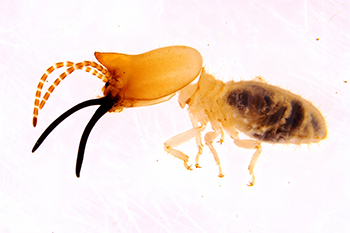
South American termite. (Image courtesy of Nathan Schiff, Research Entomologist for the Forest Service's Southern Research Station.)
In fact, Clem insists that termites are really a quite important player in the earth’s ecosystems when it comes to decomposition of rotting trees. "Their ability to eat wood is important for ecosystems around the world because they are very important decomposers,” Clem explains. “So they will totally just munch away at rotten trees. They are also important food sources for a variety of different animals, including humans. You think of something like an anteater, that eats termites."
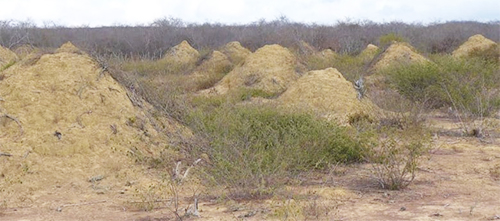
Termite mounds discovered in Brazil that are so large they are visible from space. (Photo by Stephen Martin, a social entomologist.Article link
Regarding termites’ importance in the ecosystem, Berenbaum agrees. "They are really important. And so we just wanna sort of shine a light on termites, even though they'll run away cause they're afraid of light, but we'll shine it anyway."
Clem also cites certain species in South America and Africa who have led the way in making our own homes cooler in the summer. These species build giant mounds up to 10 feet tall, with a built-in air conditioning system throughout mound. Based on these termites’ work, engineers have emulated their work—Bio-inspiration!—to produce more efficient HVAC systems. Plus, these termites are not just engineers but architects as well as master gardeners, creating fungal gardens in their colonies.
Given that the event is a film festival, another important activity was, of course, the feature film—the 2005 blockbuster, ALIEN: Apocalypse, with its star-studded cast: Bruce Campbell and Renee O'Connor. The plot? An astronaut, Dr. Ivan Hood (Campbell), and his fellow astronaut, Kelly (O’Connor), return from their mission in space to find the world has been taken over by aliens (big termites), who intend to strip the earth of all of its wood. Now Hood and Kelly must lead a revolution to free the human slaves from their alien masters (see the trailer!).
Speaking of bad movies, what is the IFFF’s philosophy behind the film choices? Clem quickly cites that it must support the year’s theme, then deftly passes the blame on to Berenbaum, indicating that she probably chose it because it was the most well-known movie about termites. Movie shorts shown before ALIEN were about the kid-friendly, Woody the Woodpecker, ostensibly because woodpeckers mostly feed on wood-boring insects such as (gasp), the termite.
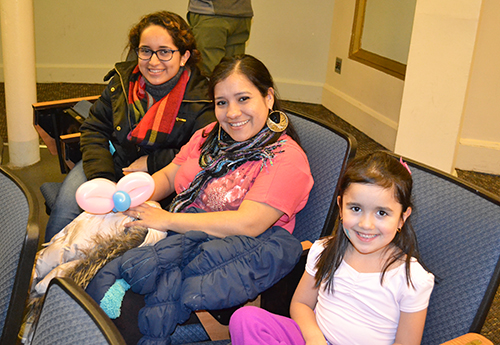
Visitors to the Festival grab their seats in order to watch the films.
Along with selecting the films, Berenbaum is also responsible for getting the rights to show them. In fact, she actually contacted Bruce Campbell this year to see if he would come to the Festival. While he seemed to be really intrigued by the idea, unfortunately he had to decline.
Just before the movie, Berenbaum was also responsible for setting the record straight about the insect they’d be shining the spotlight on (in this case, the termite), who, despite its importance in terms of decomposition, was obviously the villain and got a bad rap during the movie. Indicating that IFFF is a way for folks in Entomology to “reach out to the public," and to "talk about these different insects,” Clem continues, “It's always just a fun thing because we show all these cheesy movies.” But before the movies began, Berrenbaum took the stage and listed all the different things that were wrong about the movies and how much is actually true, sharing what the termite is really like in the real world.
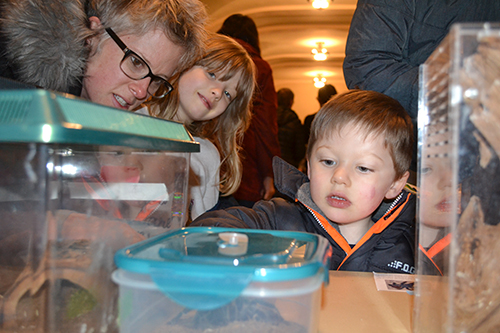 Above: A mother and her young children enjoy viewing the different insects in the petting zoo.
Above: A mother and her young children enjoy viewing the different insects in the petting zoo.
Below: An intrepid visitor holds Cecelia the Tarantula.
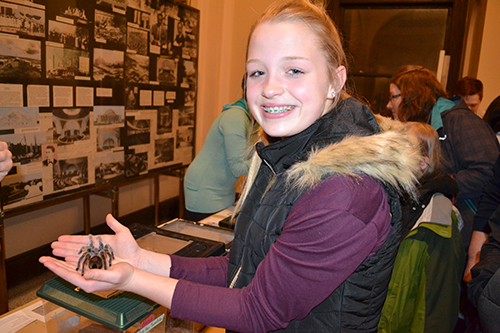
Always a fun event for families with children, the event featured EGSA’s ever-popular petting zoo, which is always a hit. For instance, lots of roaches were on hand: Madagascar hissing cockroaches, giant cave roaches, warty glowspot roaches, plus other species. “We've got a lot of those,” Clem admits. The petting zoo also featured some large lubber grasshoppers, which Clem calls “a lot of fun,” and claims. “Kids love handling those.” Plus, the zoo included some blue, death-feigning beetles, which Clem reports are always a big hit. “They're from the desert, and they'll actually roll over and fake dead, which is really cool.” Then, of course, the highlight for everyone waiting in the petting zoo line was everyone's favorite tarantula, Cecilia.
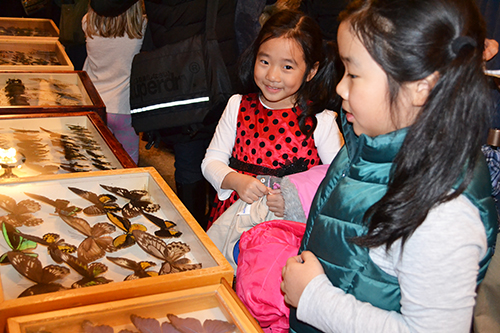
Two sisters appreicate the myriad insects on display at the Festival.
Also on display at the IFF were exotic insects from all over the world, part of Research Entomologist and Illinois alum Nathan Schiff's collection. In addition, the curator of the insect collection at the Illinois Natural History Survey sent some exotic termites that Entomology doesn’t have.
Of course, in celebration of the insect of the night, there were also special termite-related activities. For instance, someone had built a paper-mache termite mound. Plus, they had a termite-themed, hands-on activity using live termites. A participant could put a termite on a piece of paper and start drawing with a pen, like a Bic. And because a certain chemical found in the ink mimics termite pheromones, the termite would follow the path. Another important stop at the Festival was the t-shirt table, where t-shirts with the theme and the logo are sold. This year’s t-shirt featured a termite holding up a globe.
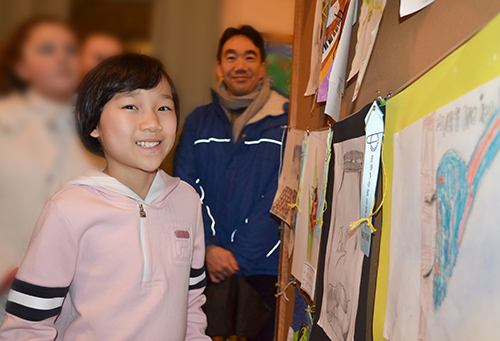
A local youth (left), son of Astronomy Professor Tony Wong, proudly shows Dad his submission.
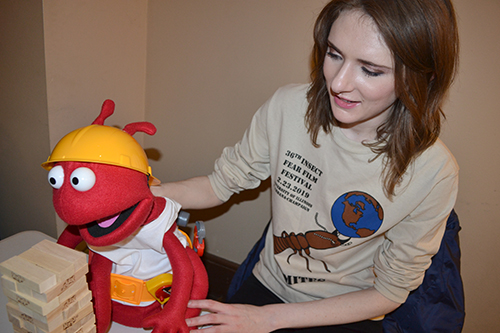
Hannah Laskowski entertains the children with her termite puppet.
The event also featured artwork submitted by local school children, some of whom showed up with their parents in tow to see their work in the exhibition. As an added incentive, winners received prizes.
Also on hand were roasted termites, so entomophagists could have a taste. (This reporter passed.) Well versed in Entomophagy (the practice of eating insects) worldwide, Clem claims that there are even Entamophagy orgies (some insects are aphrodisiacs), that cricket powder brownies are quite tasty, and that consuming insects is actually much more sustainable than modern farming practices!
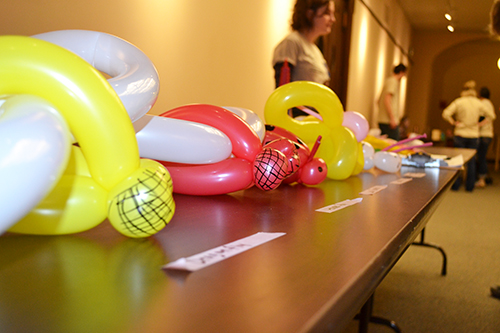
Some of the various balloon insects children could have made.
Of course, another popular area was the kids’ activities upstairs For instance, chatting with a termite puppet was ventriloquist Hannah Laskowski, May Berenbaum’s daughter, who shares that she came all the way from LA for the Insect Fear Film Festival because Mom asked her to.
"Well, I mean, my mom runs it. I've been going for most of my life, and she likes to have me do some ventriloquism with insect puppets to add something else to the festival."
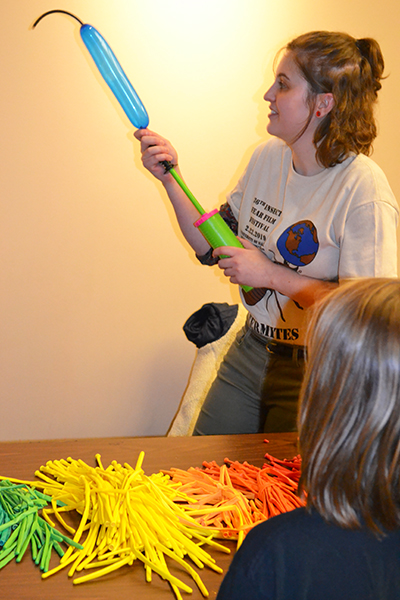
An Entomology student blows up a balloon to begin making a young visitor's ballon insect.
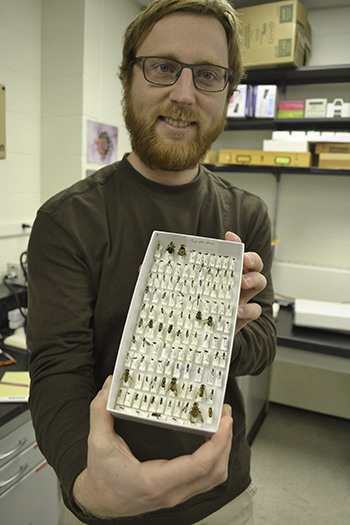
Scott Clem exhibits some of his hover fly collection.
In fact, Laskowski no doubt has built up her stock of insect puppets as a result of the Festival. She now has a bee, a cockroach, and acquired a tick puppet last year. “I think that's all the insect ones I have. And this guy is a termite! Or he can be an ant!” she discloses.
Also on hand were balloon insect experts, who were quickly turning the array of colored balloons into whatever color insect each kid wanted, including, of course, a termite. Plus, kids could also get their faces painted with their favorite insect.
What's the benefit of bringing kids to the IFFF? Clem says it’s just to teach kids about insects.
“A lot of us entomologists like to say that every kid has their bug stage, but some of us just never grow out of it. Kids tend to be less afraid of insects than their parents in a lot of cases. So we generally just wanna teach kids that insects aren't all necessarily dangerous. They all have their important value to society and the ecosystem and the environment.”
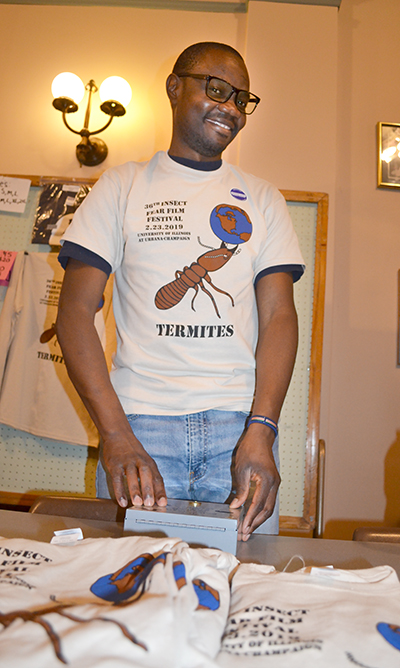
An Entomology student wears the t-shirt designed for this year's IFFF while manning the t-shirt table.
He also adds that it’s especially important for kids to learn more about their environment, because kids don't go outside as much as they used to. “It's good to be able to show them a little bit about these insects and teach them so that they can learn.”
He claims that it’s also important to teach kids that we need to help conserve beneficial insects, because insects are declining worldwide, and it's very difficult to know to what extent. For instance, entomologists believe that as the good insects are declining, pests are increasing.
“Because when you lose diversity, you end up with a few species that become really problematic,” he explains, indicating that the greatest example of this is in urban environments.
“There's not as many species, but there are a few, like cockroaches for instance, which will absolutely take out everything else and thrive. They have very little competition from other species. So it's important to have all these species to keep each other in check. So, yeah, that's another goal is to kinda teach people why they need to conserve insects, and what the importance is."
An Entomology grad student, Clem studies migratory pollinating hover flies, little black-and-yellow striped flies that mimic bees. So what you and I are thinking is a sweat bee might actually be one of the 100+ hover fly species in Illinois. In Dr. Alex Harmon-Threatt's lab, which focuses on native bees, Clem is the only one studying hover flies.
Why should we appreciate hover flies? Clem puts in a plug for his buddies: unlike regular flies, they don't spread any human diseases. Plus, he claims, “They're actually nice to have in the garden because in addition to being pollinators, the larvae feed on pest insects." They’re attracted to aphid pests specifically, and will lay eggs on aphid colonies, (something this gardener is glad to know, along with Clem’s free expert advice that in dealing with squash bugs, I should plant a trap crop.)
Story by Elizabeth Innes, Communications Specialist, I-STEM Education Initiative. Photos by Elizabeth Innes unless otherwise noted.
More: Entomology, 2019
For additional I-STEM web articles about Entomology's outreach, see:
- Club Insecta Provides Community, Resources, Outreach—and Lots of Time Out in the Fresh Air Collecting Bugs
- The 2018 Insect Fear Film Festival Helps Visitors Combat Fears and Entomophobias
- Folks From Cradle to Retirement Home Connect With Nature at Pollinatarium
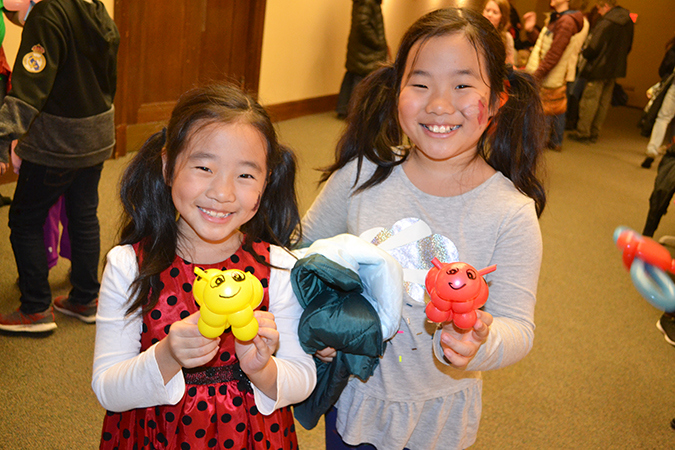
Two sisters, sporting painted faces, show off the balloon insects they got.
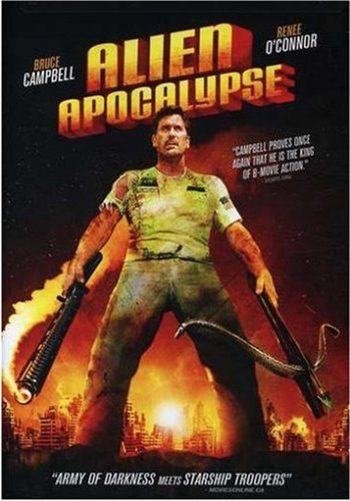













.jpg)
















